Analysis before making a decision or undertaking a new project is vital for effective execution. Weighing the benefits and risks of your decision will prepare you for the unforeseen obstacles or consequences that might come your way.
A business case serves this purpose.
A business case is the first document that is made before a project begins. In other words, it is a compact document that includes all aspects of the investments put into the project and analyses the risks and returns to help you make a rational decision.
As the name suggests, a business case is mostly used by businesses. However, its utility stretches beyond that as it can benefit you in your personal life too. It is a great way to assess whether or not the returns from an investment are worth enough to justify the risks involved.
Why Write a Business Case?
A business case shields you from bad decisions. Before initiating a project it is vital to assess the pros and cons of the situation and measure the alternatives. A business needs to be conscious while investing capital and resources in its projects to reduce potential risks and avoid failure.
It can be intimidating to ensure that you have chosen the right project. However, with an effective business case, you can rest assured that you have done your research and analysis before going ahead with the project.
How to Write a Business Case
The goal of a business case is to convey the objectives and execution of a project. These are four major steps involved in creating a concise and accurate business case:
- Define and identify the business problem
- Identify the alternative solutions
- Recommend a preferred solution
- Describe the project organizations
A business case should be drafted in the presence of people who are experts in various fields. This will assure that the information mentioned is thoroughly researched. It is important to note that the document should be reader-friendly.
Now that you are familiar with what a business case is and its significance, let’s take a look at the steps of creating a business case.
Every problem has multiple solutions and each solution has its benefits and limitations. To ensure the optimum use of resources, examining all the possible solutions is essential.
In this step, you need to list down all the possible solutions to the problem you have previously defined. Identification of the alternative solutions includes the following elements:
-
Define and identify the business problem
The purpose of a project is to solve a problem or achieve a certain objective, hence the foremost thing to do is to define the project and study the problem that needs to be solved. These are the sections that need to be included in this part of your business case:
-
Executive Summary
An executive summary is a short section that gives an overview of your document. It should be succinct in conveying vital information about the project. It should get across the anecdote about the project in simple yet persuasive words.
-
Project Objective
Here, you describe the goal you want to achieve through the project. You also specify the benefits it brings to the business. You can also give a brief intro about the solutions you suggest to solve the problem.
-
Research your market
Now, include the complete analysis of the marketplace in which your business is operating. A good start would be by including the PESTEL (political, economic, sociological, technological, environmental, and legal) analysis.
-
Problem Analysis
After the market analysis, you add a detailed analysis of the problem this project is solving. And you also mention and describe the opportunity you have through the problem that you have identified.
-
-
Identify the alternative solutions
-
Description
In this part, you describe the solution, its implementation, and the time it takes to achieve the objectives.
-
Benefits and limitations
Here, you should list down all the benefits of this particular solution and also mention any limitations it has.
-
Costs and feasibility
This will include a forecast of the costs this solution will need. Costs also include the resources and manpower used. Explain the practicality and feasibility of this solution.
-
Risks and Returns
Analyze the risks of choosing this solution, and explain them in detail. Also, forecast the return on the investment you receive through this solution.
-
-
Recommend a Preferred Solution
A problem may have a myriad of solutions. The hard part isn’t listing all the possible solutions, but selecting the best one is. It can be tempting to explore all the paths, but most times, neither do you have the resources nor the time to do it. So the ideal way to go about this situation is to put your solutions to the test. In this step, you should include the following:
-
Rank your options
After listing down the proposed solutions, you rank them and measure them with the metrics that are appropriate for your project. Explore all the benefits, risks, and timescales and compare them across the solutions.
-
Selection of a solution
Now, you select the one that’s best for you. Considering all the data and comparing all proposed solutions, you should decide the solution that is optimal for this project. It can be tricky to make this decision but effective research can help you here.
-
-
Describe the project organization
Now that you have identified the problem, and selected the ideal solution, it is time to describe how you will implement the solution. This step will include all the operations of the project, financial aspects, allocation of resources, and more.
Everything you mention in this step will help you to convince the readers that this is the best way. These are the key aspects to be included in this step:
-
-
Budget estimation
Now it is time to predict the costs that are required to complete the project in the chosen timeframe. Here, you also mention the cash flow and compare the benefits against the costs incurred.
-
Planning and scheduling
This part includes planning and making a schedule to implement the project. Create a timeline for the project and predict the time each task requires. Planning will ensure a smooth pace making it easy to detect any deviations and correct them.
-
Role and responsibilities
Now you can go ahead and assign roles and responsibilities. Create teams and assign tasks. You can also list out all the important roles.
-
Allocation of resources
After assigning roles, you specify all the resources this project will require. Mention and allocate the resources for each task.
-
Project management
All the above steps are important but they will be an asset only if the governance is effective. Here, you state the structure of the project and the decision-making process. This will give an idea of the framework of the whole project and how it will be managed.
-
-
Business Case Examples
A business case is a versatile document that can be used by anyone for any decision-making process. To get a better idea of what we are talking about, you can take a look at these business case examples.
But just to get you started, here are two simple examples that can help you understand how a business case can be used in different scenarios.
-
Example 1: Hiring an employee (Professional Use)
Executive summary:
A requirement for a new employee has emerged with the undertaking of the new project. Two alternatives were considered and the best option would be to delegate the extra work to the existing employees.
Objectives:
Complete the project efficiently
Increase ROI on this projectAlternatives:
Hire new employees to work on the new project
Delegate the project to the current employees and increase their salaryPreferred solution:
Delegating extra work to the current employees and paying overtime wages.
Benefits of the preferred solution:
Paying overtime is cheaper than paying new salaries
It is easier to predict pre-existing employees’ performance
Pre-existing employees don’t need additional training and orientationRisks/Limitations of the preferred solution:
High stress
Low morale
Decrease in productivity over timeTimescale:
The project will last for 3 months
Hiring new employees will take 2-3 monthsCosts:
25% added overtime pay to the current salaries
15% added electricity and maintenance costsAppraisal:
Delegating extra work to current employees is a better decision than hiring new employees. It gives a better ROI.
-
Example 2: Buying a car (Personal Use)
Reasons:
William needs a vehicle to commute to his new job which is far from home.
William’s son needs a safer way to get to school due to his fractured leg.Alternatives:
Buy a new car
Buy a second-hand car
Use public transportPreferred solution:
Buying a second-hand car
Benefits of the preferred solution:
Alex can get to work quick
William’s son has a safer way to get to school
A second-hand car is cheaperRisks/Limitations of the preferred solution:
A second-hand car has a lower lifespan and durability
A second-hand would not come with a free 1-year warranty
Daily use of the car would generate a high carbon footprintTimescales:
2 months to find a good car deal
1 year of paying insuranceCosts:
Car cost – $10,000 to $15,000
Gas – $100 per month
Maintenance – $1000 per yearAppraisal:
Is it worth investing $15,000 for conveyance? – Yes
Is a second-hand car affordable? –Yes
Make the Right Decisions with a Business Case
Trying to make a business decision invites a lot of possibilities—ones that you have to study and analyze thoroughly before forming a conclusion. The same is better done using a business case as it provides you with a well-structured and procedural way to pick and execute a business decision.








